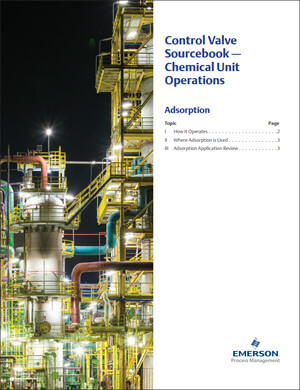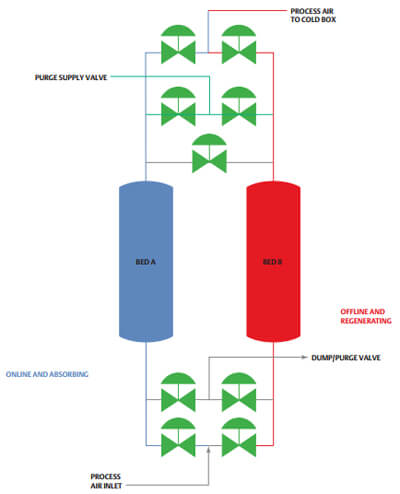 Many techniques are used to separate impurities in fluids. One common method is to use the process of adsorption. In an online document, Control Valve Sourcebook — Chemical Unit Operations, adsorption is defined as:
Many techniques are used to separate impurities in fluids. One common method is to use the process of adsorption. In an online document, Control Valve Sourcebook — Chemical Unit Operations, adsorption is defined as:
…a typical mass transfer operation used in process plants to remove or separate specific components of a liquid or gaseous mixture. The specific definition of adsorption is the adhesion of atoms, ions, or molecules to a solid surface.
How it differs from absorption is that:
…absorption consumes the particles, while adsorption is the binding of molecules or particles to a surface. This binding takes place primarily on the walls of the porous material. In a process known as regeneration, the sorbent, or material performing the adsorption is purged of particles that have adhered to the sorbent.
Three types of regeneration processes include:
- Pressure swing adsorption (PSA)
- Temperature swing adsorption (TSA)
- Vacuum pressure swing adsorption (VPSA)
 In a dual bed arrangement, one adsorption bed can be adsorbing while the other is offline and regenerating. The article provides an example of an oxygen and nitrogen air separation process:
In a dual bed arrangement, one adsorption bed can be adsorbing while the other is offline and regenerating. The article provides an example of an oxygen and nitrogen air separation process:
During the production step, air is pumped into a cylinder containing beads of adsorbent material at pressure. Adsorbent material is selected based on what component of the air is needed. As the air passes through the bed, the adsorbent material separates the unwanted air components and only allows the desired product to pass through. During the regeneration step, a small amount of product nitrogen or oxygen is used to flush the waste gas through an exhaust port, preparing the vessel for another production cycle.
Other examples where the adsorption process is used include:
- Removal of sulfur compounds from natural gas
- Removal of water content in cracked gas for ethylene production
- Air separation units
- Dehydration of ethanol
- Clarification of sugar
- Softening of hard water
- Carbon dioxide (CO2) removal
Critical valves used in adsorption processes include switching valves, feed gas valves, dump/purge valves, purge supply valves, product/repressurization valves and equalization process valves. Sizing the valves correctly for the application depends on the regeneration process type as well as the process pressure, temperature and fluid materials.
For example, the:
TSA process the cycle time is around eight hours and much longer than the PSA and VPSA process. The PSA and VPSA switching process take between one to three minutes.
Since pressure changes more rapidly than temperature, controlling the pressure is important to avoid fluffing the beds. Technologies that can help include [hyperlinks added]:
Fisher and Bettis actuators can be used for fast switching and accurate control. Also, Fisher FIELDVUE DVC6200 digital valve controllers are used to ensure accuracy when opening the switching valves so they are not opened too quickly.
Read the control valve sourcebook article for examples and recommended valve and actuator selections for the other valves used in the adsorption and bed regeneration processes.
You can also connect and interact with other valve and actuator experts in the Actuators and Valves groups in the Emerson Exchange 365 community.
